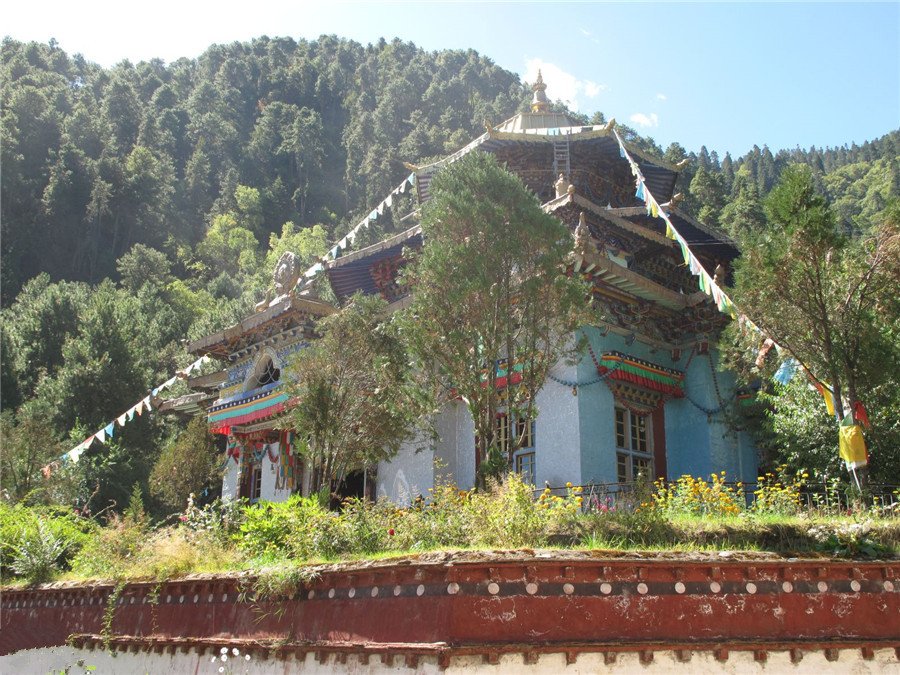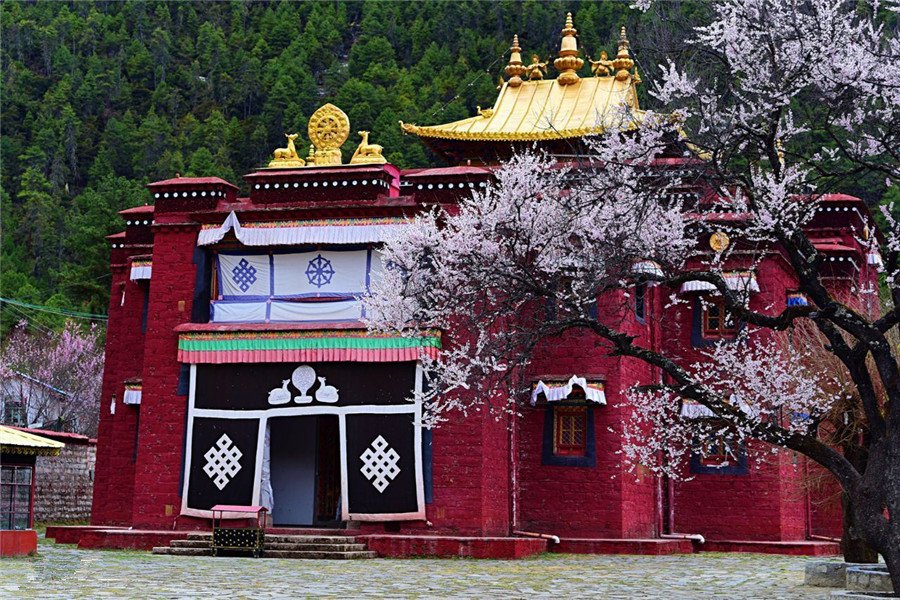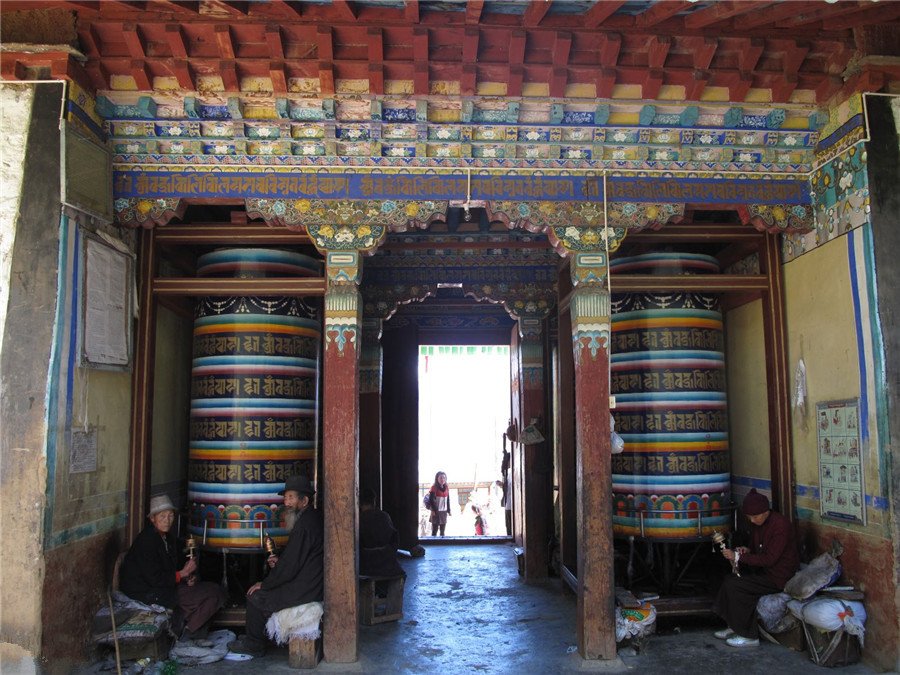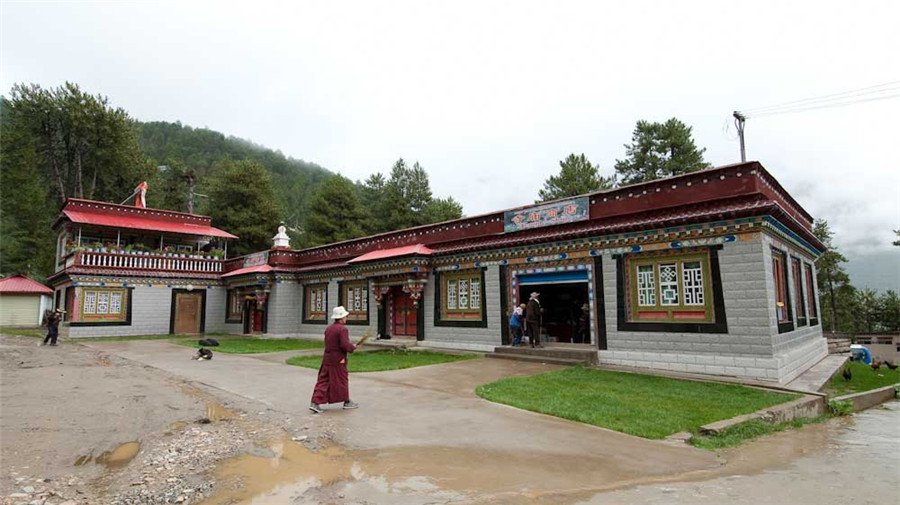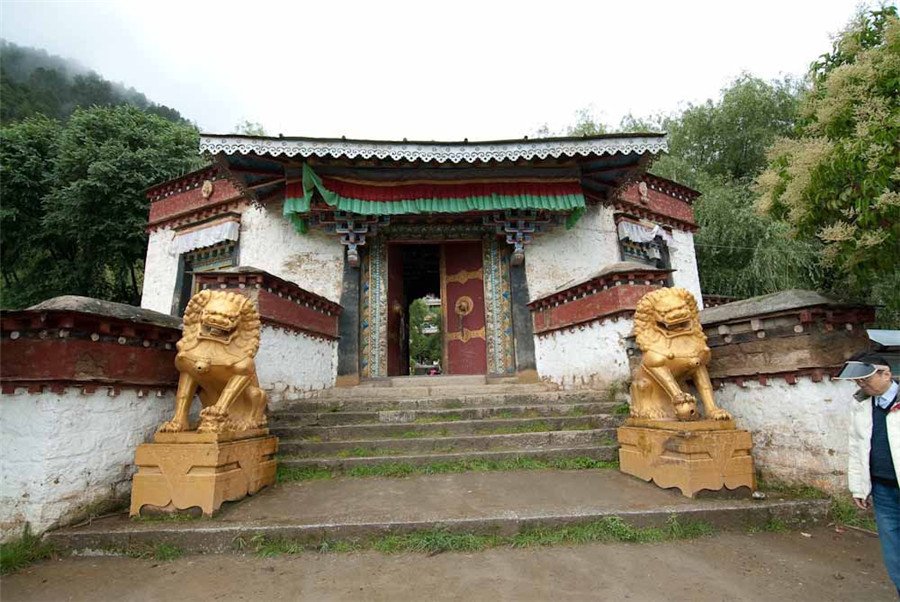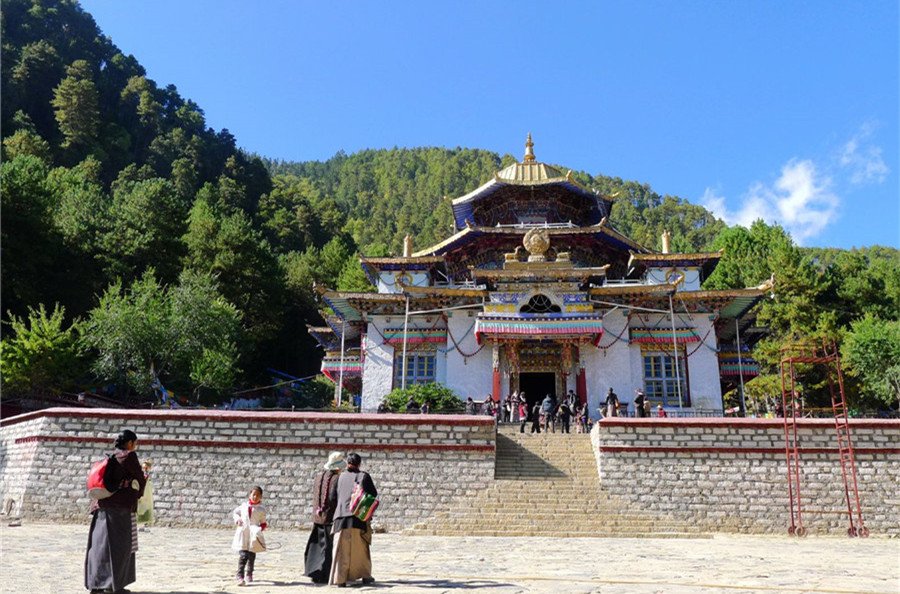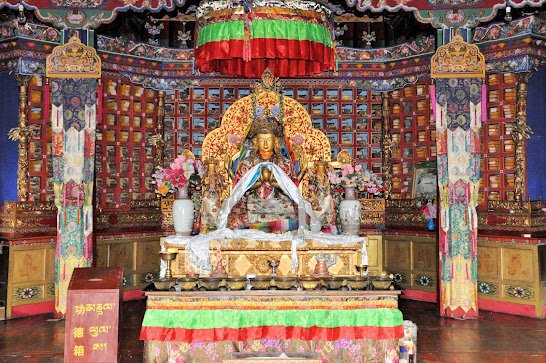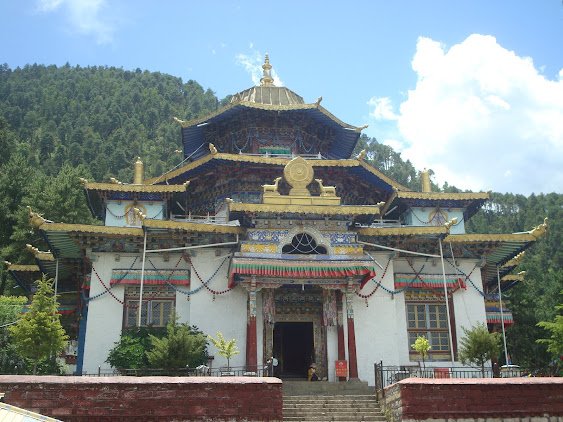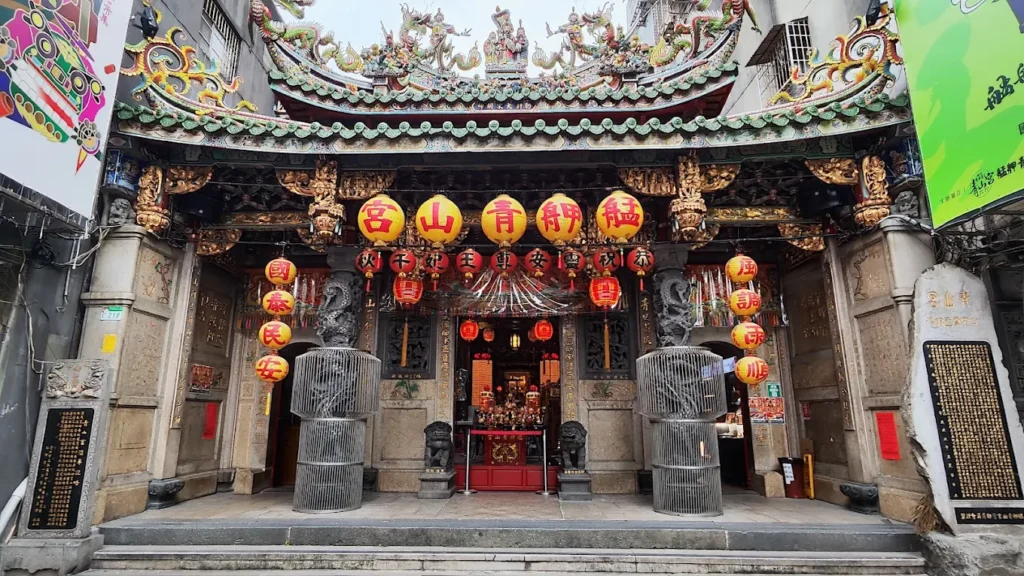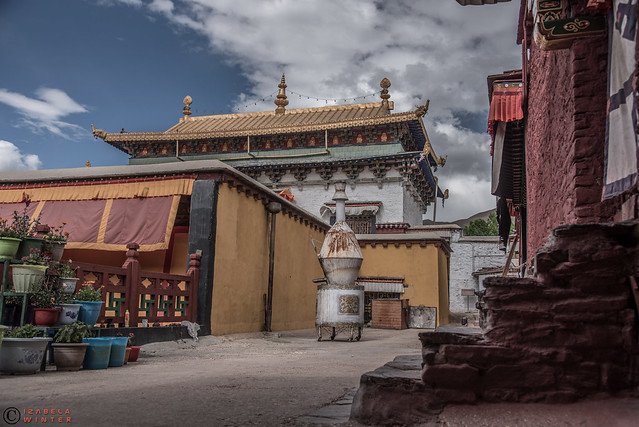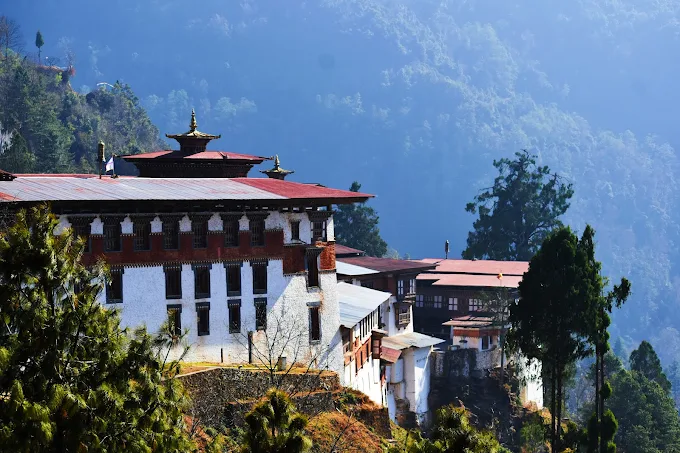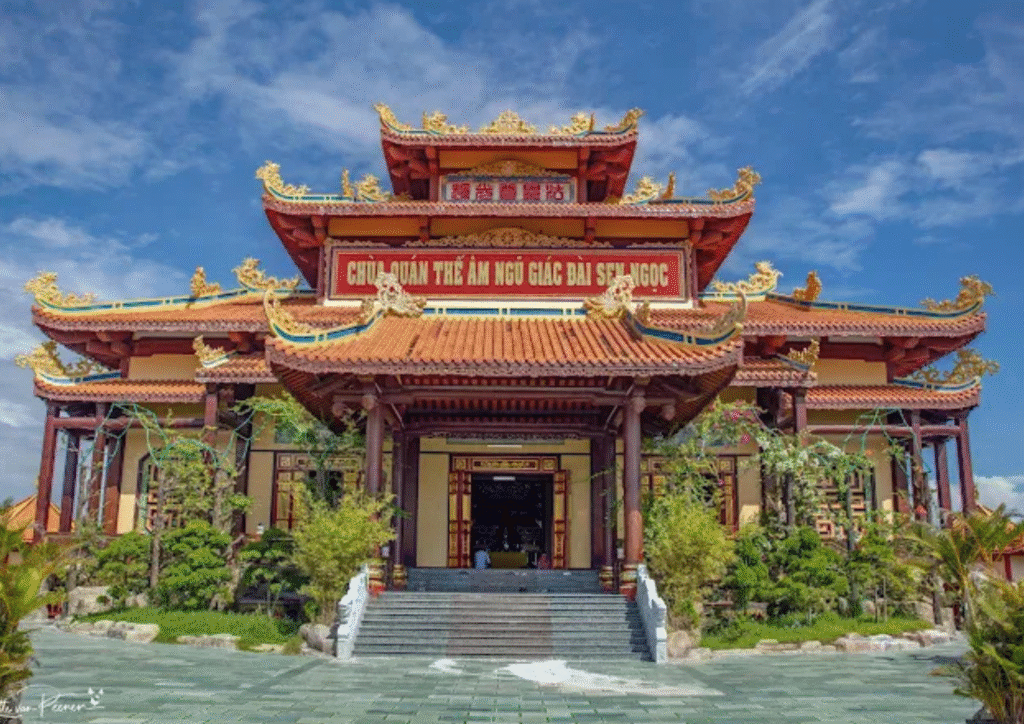Lamaling Monastery: The Octagonal Jewel of Nyingma Serenity
Lamaling Monastery, nestled amidst the lush forests 20 km southwest of Bayi Town in Nyingchi County, Tibet, radiates as a sacred haven of the Nyingma sect, its unique octagonal design symbolizing the mandala of enlightenment. Founded in the 7th century and rebuilt in the 1980s under Lama Yungdrung Lingpa, this serene gompa, known as Sang-ngag Zimche Gompa, stands as a testament to Guru Rinpoche’s legacy. At 3,000 meters, its golden roof and whitewashed walls gleam against Nyingchi’s verdant valley, captivating pilgrims and travelers with its tranquil allure. This immersive listing unveils Lamaling’s essence, guiding you through its storied past, architectural splendor, sacred rituals, and practical visitor insights, offering a journey into a hidden gem of Tibetan Buddhism.
The Sacred Mandala of Lamaling
Essence of Lamaling Monastery
Lamaling Monastery pulses with the esoteric wisdom of the Nyingma sect, embodying Tibet’s oldest Buddhist tradition through its devotion to Guru Rinpoche and Dzogchen teachings. Rebuilt in the 1980s after its 7th-century origins, it serves as a spiritual retreat, drawing devotees to its mandala-inspired halls. Its defining feature—an octagonal architecture, rare in Tibetan gompas—mirrors the cosmic wheel of enlightenment, setting it apart. Tucked in Nyingchi’s forested embrace, Lamaling’s serene isolation invites profound reflection on Tibet’s spiritual heritage.
- Spiritual Core: Nyingma sect retreat, Dzogchen focus.
- Iconic Feature: Octagonal mandala-inspired design.
- Cultural Role: Preserver of Guru Rinpoche’s legacy.
Historical Evolution
Lamaling’s origins trace to the 7th century, when Guru Rinpoche is said to have meditated in its caves, blessing the site as a sacred retreat. The monastery, formally established later, flourished under Nyingma masters until the Cultural Revolution (1966–1976) razed its structures. In the 1980s, Lama Yungdrung Lingpa led its reconstruction, restoring its octagonal form and golden roof with local support. The 1989 consecration, attended by the 14th Dalai Lama, marked its revival, cementing its role as a Nyingma sanctuary, as noted in local accounts and travel guides.
- Founding: 7th-century origins, Guru Rinpoche’s blessing.
- Destruction: Razed during Cultural Revolution.
- Restoration: Rebuilt in 1980s, consecrated in 1989.
Cultural Impact
Lamaling’s octagonal design and Nyingma rituals have shaped Tibet’s spiritual landscape, inspiring gompas across the region. Its preservation of Guru Rinpoche’s terma teachings, studied via HimalayanArt.org, reinforces Nyingma’s esoteric tradition. Annual festivals, like the Guru Rinpoche Drubchen, draw Nyingchi pilgrims, maintaining vibrant customs. Globally, Lamaling attracts cultural enthusiasts through narratives on Tibet Travel, resonating with those exploring Tibet’s Nyingma heritage, as documented in Dudjom Rinpoche’s The Nyingma School of Tibetan Buddhism.
- Nyingma Influence: Guru Rinpoche’s terma teachings.
- Festival Traditions: Guru Rinpoche Drubchen preserves customs.
- Global Appeal: Draws cultural enthusiasts, scholars.
Signature Legacy
The octagonal Tsuglhakhang, rebuilt in the 1980s, is Lamaling’s crowning jewel, its eight-sided form symbolizing the mandala’s cosmic harmony, unique among Tibetan monasteries. A sacred Guru Rinpoche statue, enshrined in the main hall, radiates blessings, believed to embody his meditative presence from the 7th century. A legend recounts how Guru Rinpoche left a footprint in a nearby cave, affirming Lamaling’s sanctity. These elements define Lamaling’s spiritual and architectural allure.
- Octagonal Tsuglhakhang: Mandala-inspired design.
- Guru Rinpoche Statue: 7th-century blessed relic.
- Footprint Legend: Guru Rinpoche’s cave imprint.
Community and Global Reach
Nyingchi locals revere Lamaling, offering butter lamps during festivals and life events, viewing it as a protective sanctuary. Its 30 monks maintain rituals and guide visitors, fostering spiritual continuity. The Tibetan diaspora connects through Nyingma networks, while international tourists, drawn by China Highlights, seek its serene authenticity. Social media posts on X and travel blogs highlight Lamaling’s golden roof, linking it to global Buddhist communities.
- Local Devotion: Butter lamp offerings by Nyingchi residents.
- Monastic Community: 30 monks uphold rituals.
- Global Appeal: Attracts diaspora, niche tourists.
Architectural Splendor of Lamaling
Distinctive Design
Lamaling’s architecture, spanning 2,500 square meters at 3,000 meters, merges traditional Tibetan aesthetics with a rare octagonal mandala layout, its whitewashed walls and golden roof harmonizing with Nyingchi’s forested valley. Centered on the Tsuglhakhang, it features a courtyard with chortens and prayer wheels, reflecting 7th-century Nyingma styles revived in the 1980s. The eight-sided design, symbolizing the Buddhist wheel, creates a serene aesthetic, unique to Lamaling’s spiritual purpose.
- Style: Tibetan octagonal, Nyingma symbolism.
- Layout: Tsuglhakhang, courtyard, chortens.
- Setting: White walls in forested Nyingchi valley.
Signature Structures
The Tsuglhakhang, a two-story octagonal hall restored in the 1980s, enshrines the Guru Rinpoche statue and thangkas of Nyingma deities, glowing under butter lamp light. The Zangdok Palri Lhakhang, a side chapel, houses Chenresig and Tara statues, adorned with vibrant murals. The golden roof, regilded in 1989, crowns the structure, reflecting sunlight across the valley. The outer kora path, lined with 108 prayer wheels, encircles a chorten commemorating Guru Rinpoche’s blessing, inviting devotion.
- Tsuglhakhang: Octagonal hall, Guru Rinpoche statue.
- Zangdok Palri Lhakhang: Chenresig, Tara statues.
- Golden Roof: Regilded valley beacon.
Artisanal Mastery
Lamaling’s thangkas, crafted by monks, depict Nyingma deities like Vajrakilaya with mineral pigments, their hues vibrant post-1980s restoration. The Guru Rinpoche statue, recarved in the 1980s, echoes 7th-century sculptural finesse, its serene gaze captivating devotees. Carved wooden beams, featuring lotus motifs, adorn the Tsuglhakhang, while silk thangkas of Guru Rinpoche’s manifestations hang in chapels. These works, preserved through meticulous restoration, highlight Lamaling’s artistic legacy.
- Thangkas: Nyingma deities, vibrant pigments.
- Guru Rinpoche Statue: 1980s recarved relic.
- Wood Carvings: Lotus-motif beams, silk thangkas.
Hidden Architectural Gems
Lamaling conceals subtle treasures within its sacred grounds. The kora path’s forested overlook offers intimate views of Nyingchi’s valley, framed by prayer flags. A faded mural in the Zangdok Palri Lhakhang depicts Guru Rinpoche’s meditation, a historical glimpse. The courtyard’s mani stone pile, etched with Om Mani Padme Hum, invites quiet reflection, while a nearby cave shrine holds a stone with Guru Rinpoche’s footprint, believed to bless pilgrims.
- Kora Overlook: Nyingchi valley views.
- Meditation Mural: Guru Rinpoche artwork in Lhakhang.
- Footprint Shrine: Guru Rinpoche’s cave relic.
Preservation and Evolution
Preserving Lamaling’s structures is challenging in Nyingchi’s humid climate. Restoration since the 1980s, funded by local devotees and Nyingma patrons, used traditional pigments for thangkas and reinforced mud-brick walls. The golden roof’s regilding in 1989 blended modern durability with ancient aesthetics. Ongoing efforts, supported by modest donations, aim to maintain the octagonal design, ensuring Lamaling’s legacy endures despite environmental risks.
- Restoration: Pigments, wall reinforcements since 1980s.
- Golden Roof: Regilded in 1989.
- Funding: Local, Nyingma devotees.
Sacred Rites and Nyingma Devotion
Sacred Daily Rites
Each dawn, Lamaling stirs with gentle chants, as monks gather in the Tsuglhakhang, their voices blending with butter lamp smoke. Pilgrims offer khatas (silk scarves) at the Guru Rinpoche statue, their prayers mingling with juniper incense. The hum of 108 prayer wheels along the kora path creates a meditative rhythm, enveloping visitors in Lamaling’s spiritual calm.
- Chanting: Morning sutras in Tsuglhakhang.
- Offerings: Khatas at Guru Rinpoche statue.
- Ambiance: Incense, prayer wheel hum.
Unique Spiritual Practices
Lamaling’s monks perform Nyingma rituals, including Guru Rinpoche-focused recitations and Dzogchen meditations, reflecting the sect’s esoteric roots. Pilgrims walk the kora, spinning prayer wheels to accrue merit, a practice tied to the monastery’s mandala design. The Zangdok Palri Lhakhang hosts Chenresig blessings, unique to Lamaling’s terma tradition, believed to cultivate compassion. These rituals, rooted in Guru Rinpoche’s legacy, deepen the monastery’s spiritual allure.
- Guru Rinpoche Rites: Nyingma recitations, meditations.
- Kora: 108 prayer wheel circumambulation.
- Chenresig Blessings: Terma-inspired compassion rites.
Vibrant Festival Traditions
Lamaling’s festivals transform the monastery into a vibrant devotional hub. The Guru Rinpoche Drubchen, held in the tenth lunar month, features seven-day tantric rituals and Cham dances depicting Guru Rinpoche’s triumphs, drawing Nyingchi pilgrims. Saka Dawa, marking Buddha’s enlightenment, includes kora walks, lamp offerings, and communal feasts of tsampa (roasted barley) and butter tea. These events reinforce Lamaling’s role as a cultural and spiritual anchor.
- Guru Rinpoche Drubchen: Seven-day tantric rites, Cham dances.
- Saka Dawa: Kora, lamp offerings, feasts.
- Community Role: Tsampa, tea shared.
Visitor Engagement
Visitors can offer khatas or light butter lamps at the Guru Rinpoche statue, guided by monks, immersing in Lamaling’s spiritual life. Photography is permitted for a 10-yuan fee, capturing thangkas and the octagonal hall, but flash is prohibited, and the main statue restricts close-up shots. Joining the kora lets travelers walk with pilgrims, feeling Lamaling’s sacred rhythm. Monks may share tales of Guru Rinpoche’s cave meditation, enriching the visit with historical lore.
- Offerings: Khatas, lamps with monk guidance.
- Photography: 10-yuan fee, no flash, restricted statue shots.
- Kora Participation: Walk with pilgrims.
Monastic and Community Roles
Lamaling’s 30 monks, primarily Nyingma, maintain daily rites, study terma texts, and guide visitors, upholding its esoteric legacy. They offer blessings for local harvests, weddings, and life events, strengthening Nyingchi ties. The monastery trains young monks in thangka painting and ritual dance, preserving Nyingma artistry. This bond ensures Lamaling remains a living spiritual center, fostering devotion in the valley.
- Monastic Duties: Rites, study, visitor guidance.
- Community Ties: Blessings for local events.
- Art Preservation: Thangka, dance training.
Visiting Lamaling Monastery
Navigating to Lamaling Monastery
Lamaling lies 20 km southwest of Bayi Town in Nyingchi County, approximately 400 km east of Lhasa, in a forested valley. From Lhasa, a 400-km drive via the G318 highway takes 6–7 hours by private tour vehicle or bus, passing Nyingchi’s lush landscapes. From Bayi Town, a 25-minute taxi or hired vehicle along a rural road southwest reaches the monastery, marked by its golden roof and octagonal hall. The nearby Basum Lake, 50 km away, serves as a contextual landmark.
- From Lhasa: 6–7-hour drive, 400 km via Bayi.
- From Bayi Town: 25-minute taxi, 20 km southwest.
- Local Access: Rural road from Bayi, near Basum Lake.
Address of Lamaling Monastery
- Location: Nyingchi County, Tibet Autonomous Region, China.
- Coordinates: 29.6667° N, 94.2833° E (approximate).
- Context: 20 km southwest of Bayi Town, Nyingchi valley.
Visiting Hours and Etiquette
Lamaling is open daily from 9:00 AM to 5:00 PM, with early visits recommended for tranquility and cooler temperatures. Dress modestly, covering shoulders and knees, and remove hats in the Tsuglhakhang to show respect. Photography is allowed for a 10-yuan fee; bring a flashlight for dim interiors, avoid flash, and note that close-up shots of the Guru Rinpoche statue are restricted. Respect pilgrims by maintaining silence, walking clockwise around sacred areas, and not touching relics or murals.
- Hours: 9:00 AM–5:00 PM, best in morning.
- Dress Code: Modest clothing, no hats in hall.
- Etiquette: 10-yuan photo fee, no flash, clockwise movement.
Accessibility and Safety
Lamaling’s grounds are accessible via a flat dirt path, but the Tsuglhakhang’s upper floor involves steep stairs, challenging for those with mobility issues. Wheelchair users require assistance due to uneven terrain; arrange with tour operators in Bayi. Nyingchi’s 3,000-meter altitude is lower than Lhasa, easing acclimatization, but hydrate and rest to avoid sickness. The rural setting is safe, but watch for stray dogs and carry cash, as no ATMs or shops are nearby.
- Accessibility: Flat dirt path, steep upper hall stairs.
- Mobility Aids: Limited, arrange assistance.
- Safety: Hydrate, watch for dogs, carry cash.
Amenities and Surroundings
Lamaling offers minimal amenities, with restrooms at the base but no shops or dining; bring water, snacks, and essentials. Bayi Town’s markets, 20 km away, serve momos (dumplings), butter tea, and yak-meat noodles, immersing visitors in local flavors. The monastery’s courtyard, with prayer flags and chortens, provides serene reflection spots. Nyingchi’s forested valley, dotted with pines and the nearby Yarlung Tsangpo River, offers scenic exploration, enriching the visit.
- Amenities: Restrooms, no shops, bring essentials.
- Food: Bayi markets with momos, tea.
- Surroundings: Courtyard, Nyingchi forests, Yarlung Tsangpo.
Immersive Visitor Tips
Arrive at dawn to hear monks chanting in the Tsuglhakhang, their voices resonating with butter lamp glow, creating a meditative atmosphere. Photograph the octagonal hall from the courtyard at midday, capturing its golden roof against the forest, paying the 10-yuan fee and avoiding flash. Walk the kora at dusk, when Nyingchi’s pines glow golden, enhancing Lamaling’s serene ambiance. Savor butter tea in Bayi’s markets, chatting with locals about Guru Rinpoche’s footprint legend for cultural depth.
- Dawn Visits: Hear chants in Tsuglhakhang.
- Photography: Octagonal hall shots, 10-yuan fee, no flash.
- Evening Kora: Forest views at dusk.
